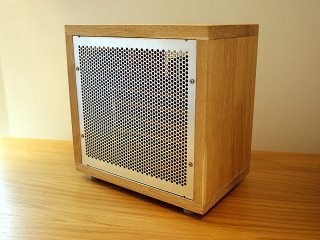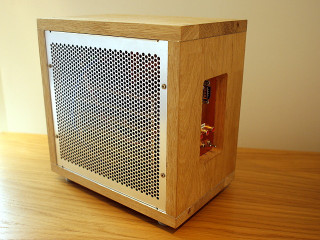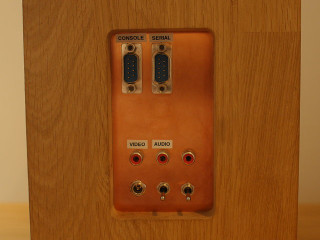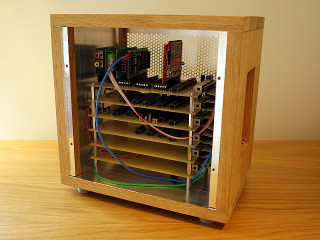The MC3 had expanded way beyond the initial enclosure and really needed to move into something bigger. Having exposed boards feels risky. Especially with these scarce old components. I really do not want to accidentally kill anything. Also I did not want to just put everything in a standard boring electronic box. The all CMOS based MC3 does not generate much heat so active cooling is not needed but a well ventilated case also ables for some peeking inside which is fun. Isolation to reduce RFI and protect from ESD was also added to the requirement specification. It looked like I would need to design something from scratch. Old wooden TV-sets have always fascinated me. Dad worked as a TV repairman many years ago and as a kid I remember watching him working with those old wooden TV's. That's my inspiration for the MC3 enclosure. Time to warm up the
Festools and get cutting!
First off I decided to use edge glued oak as the base for the enclosure. It makes it all pretty robust and also look a bit more furniture-ish. The construction is a plain wooden frame with perforated side panels of aluminum. Those panels are actually ventilated sides made for Schroff 19" enclosures that I found in the scrap pile at work. Oak does not provide any ESD protection or RFI isolation to speak of so I dressed the inside of the wooden parts with aluminum tape.

The front side of the box has no buttons for a clean look. Since I use the RS-232 reset circuit I very rarely need to access the physical reset switch anyway.

On the back there is a cut-out in the wood for an access panel containing all connectors and buttons.

A view of the back panel. Some space left for expansion.

Both aluminum side panels can be removed. The main boards are stacked and screwed to the bottom with screws that go all the way through. Even when the aluminum sides are on it's possible to get a glimpse of what's inside. Also visible here is the aluminum tape on the wooden parts. Boards mounted here are from top to bottom; I/O expansion board with a few mini I/O boards on top, video board, CPU board and extended RAM board. The two boards on the bottom are empty for further expansion.
Now it feels safe to let the cat stroll around the computer again!
 The front side of the box has no buttons for a clean look. Since I use the RS-232 reset circuit I very rarely need to access the physical reset switch anyway.
The front side of the box has no buttons for a clean look. Since I use the RS-232 reset circuit I very rarely need to access the physical reset switch anyway.
 On the back there is a cut-out in the wood for an access panel containing all connectors and buttons.
On the back there is a cut-out in the wood for an access panel containing all connectors and buttons.
 A view of the back panel. Some space left for expansion.
A view of the back panel. Some space left for expansion.
 Both aluminum side panels can be removed. The main boards are stacked and screwed to the bottom with screws that go all the way through. Even when the aluminum sides are on it's possible to get a glimpse of what's inside. Also visible here is the aluminum tape on the wooden parts. Boards mounted here are from top to bottom; I/O expansion board with a few mini I/O boards on top, video board, CPU board and extended RAM board. The two boards on the bottom are empty for further expansion.
Now it feels safe to let the cat stroll around the computer again!
Both aluminum side panels can be removed. The main boards are stacked and screwed to the bottom with screws that go all the way through. Even when the aluminum sides are on it's possible to get a glimpse of what's inside. Also visible here is the aluminum tape on the wooden parts. Boards mounted here are from top to bottom; I/O expansion board with a few mini I/O boards on top, video board, CPU board and extended RAM board. The two boards on the bottom are empty for further expansion.
Now it feels safe to let the cat stroll around the computer again!